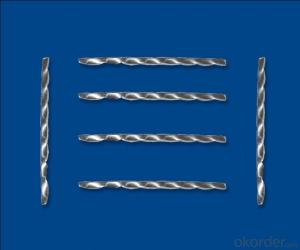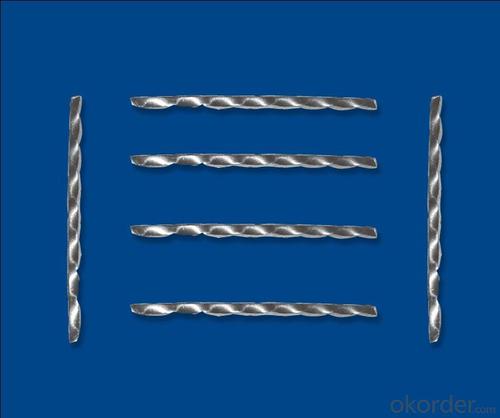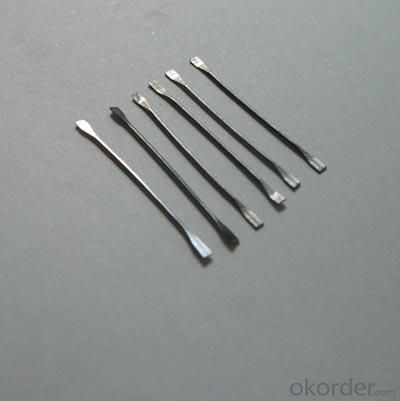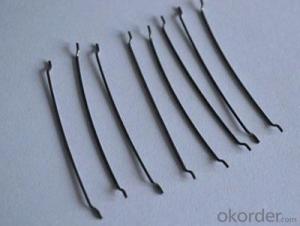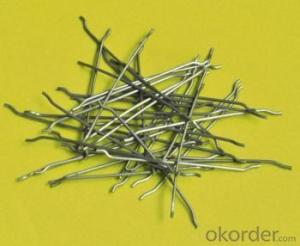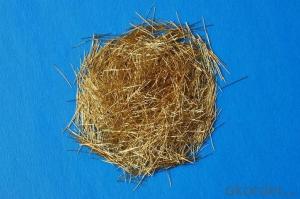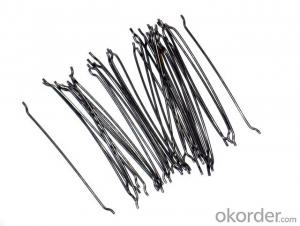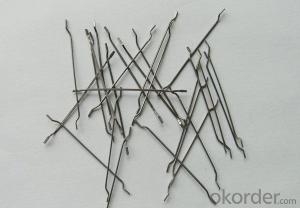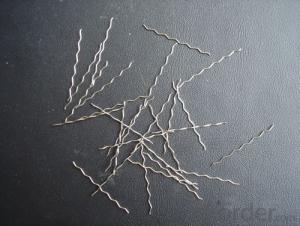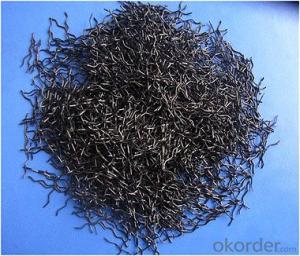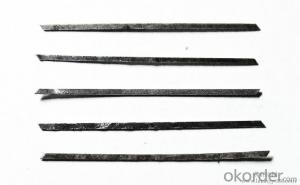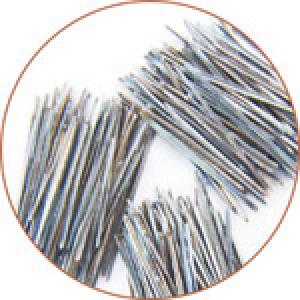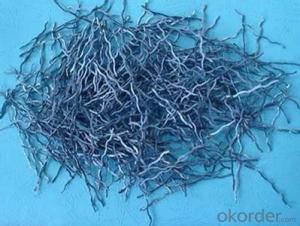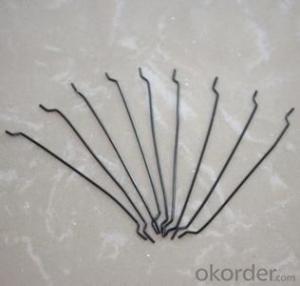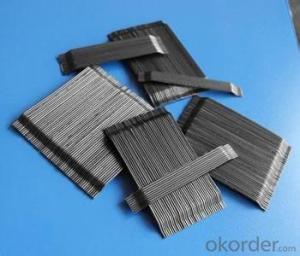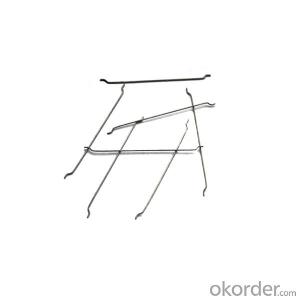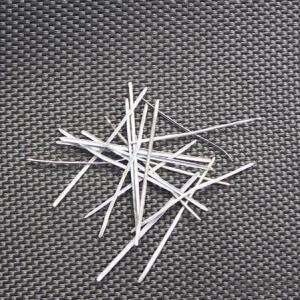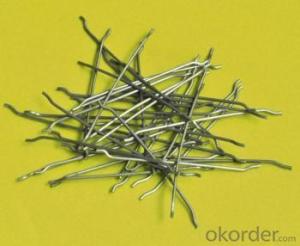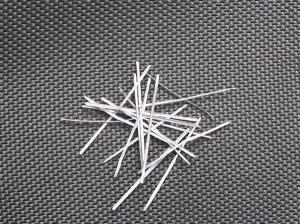Melt Extract Stainless Steel Fiber - Steel Fiber Popular Wholesale for Industrial Floor Minimum Tensile Strength
- Loading Port:
- Tianjin
- Payment Terms:
- TT OR LC
- Min Order Qty:
- 5 kg
- Supply Capability:
- 250000 kg/month
OKorder Service Pledge
OKorder Financial Service
You Might Also Like
Quick Details
Dimensions: steel wire
Grade: steel wire
Application: for concrete reinorcement
Shape: clear and bright
material: steel wire
type: wavy steel fiber
shape: corrugated flat fiber
usage: concrete reinforcement
appearance: clear and bright
Place of Origin: Shandong, China (Mainland)
Product features
steel fiber are for concrete construction, greatly improves concrete bonding and tensile strength .
Industrial floor
Precast elements
Tunnel bridge
Highway pavement
Airport pavement
The mining industry
Residential application
Concrete reinforcement
Corrosion protection
Military engine
Specifications
1: Goods: low carbon steel fiber
2: Brand: Jinzhuwang steel fiber
3:Process: Cold drawn
4:Certificate: CE, ISO9001
5:Specification is as follows
Item | Diameter (mm) | Length (mm) | Aspect Radio (L/D) | Tensile Strength (MPa) |
G50/ 25BN | 0.5 | 25 | 50 | ≥1100 |
G60/ 30BN | 0.5 | 30 | 60 | ≥1100 |
G70/ 35BN | 0.5 | 35 | 70 | ≥1100 |
G70/ 35BN | 0.6 | 25 | 42 | ≥1100 |
G50/ 30BN | 0.6 | 30 | 50 | ≥1100 |
G58/ 35BN | 0.6 | 35 | 58 | ≥1100 |
G40/ 30BN | 0.75 | 30 | 40 | ≥1100 |
G47/ 35BN | 0.75 | 35 | 47 | ≥1100 |
G80/ 60BN | 0.75 | 60 | 80 | ≥1100 |
G38/ 30BN | 0.8 | 30 | 38 | ≥1100 |
G44/ 35BN | 0.8 | 35 | 44 | ≥1100 |
G75/ 60BN | 0.8 | 60 | 75 | ≥1100 |
G56/ 50BN | 0.9 | 50 | 56 | ≥1100 |
G67/ 60BN | 0.9 | 60 | 67 | ≥1100 |
G50/ 50BN | 1.0 | 50 | 50 | ≥1100 |
G60/ 60BN | 1.0 | 60 | 60 | ≥1100 |
Picture
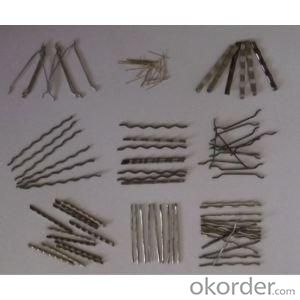
steel fiber concrete reinforced
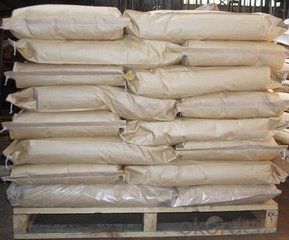
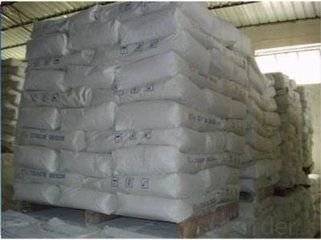

FAQ
we can produce any type steel fiber and of course we can make production according to your requirement
we have specilize in this field for almost 10 years ,with good quality and competitive price
a:Long durability
b:Once the project completed, the rate of crash will be declined a lot, a lot.
c:Economically effective
d:Steel fiber are proven the most effective and economical methods of building diverse concrete buidings
e:Extremely short project time
- Q: Does melt extract stainless steel fiber affect the color or appearance of concrete?
- No, melt extract stainless steel fiber does not affect the color or appearance of concrete. This type of fiber is typically added to concrete mixtures as a reinforcement material, rather than for aesthetic purposes. The fibers are usually small and thin, and when mixed into the concrete, they blend in with the rest of the materials and do not alter the color or appearance of the finished product. The primary function of melt extract stainless steel fibers is to improve the strength and durability of the concrete, making it more resistant to cracking and enhancing its overall performance.
- Q: Can melt extract stainless steel fiber be used in underground parking structures or garages?
- Yes, melt extract stainless steel fiber can be used in underground parking structures or garages. Stainless steel fibers are commonly used in concrete to enhance its mechanical properties, such as improving its tensile strength, ductility, and resistance to cracking. In underground parking structures or garages, where the concrete is exposed to various environmental factors like moisture, chlorides, and carbonation, the addition of stainless steel fibers can significantly improve the durability and longevity of the concrete. Stainless steel fibers are resistant to corrosion, which is especially important in underground structures where the concrete may be exposed to moisture and chloride ions, both of which can cause corrosion of reinforcement. The addition of stainless steel fibers in the concrete can provide an additional layer of protection against corrosion, thus extending the service life of the structure. Furthermore, the use of stainless steel fibers can also enhance the structural performance of the concrete. The fibers act as reinforcement, improving the tensile strength and ductility of the concrete. This can help to prevent cracking and improve the overall structural integrity of the parking structure or garage. In conclusion, melt extract stainless steel fiber can be an advantageous addition to concrete in underground parking structures or garages. Its resistance to corrosion and ability to improve the mechanical properties of the concrete make it a suitable choice for enhancing the durability and structural performance of these types of structures.
- Q: Does melt extract stainless steel fiber improve the resistance to carbonation in shotcrete?
- Yes, melt extract stainless steel fiber does improve the resistance to carbonation in shotcrete.
- Q: Does melt extract stainless steel fiber enhance the impact resistance of concrete slabs?
- Yes, melt extract stainless steel fiber does enhance the impact resistance of concrete slabs.
- Q: Can melt extract stainless steel fiber be used in the construction of parking structures?
- Yes, melt extract stainless steel fiber can be used in the construction of parking structures. Stainless steel fibers are commonly used as reinforcement in concrete to enhance its strength and durability. These fibers are able to improve the crack resistance and impact resistance of concrete, making it more suitable for high-traffic areas such as parking structures. Additionally, stainless steel fibers offer excellent resistance to corrosion and can withstand harsh environmental conditions, ensuring the longevity of the parking structure. Overall, using melt extract stainless steel fiber in the construction of parking structures is a viable option to enhance their structural integrity and increase their lifespan.
- Q: Can melt extract stainless steel fiber be used in refractory applications?
- Yes, melt extract stainless steel fiber can be used in refractory applications. Stainless steel fibers are known for their high temperature resistance and excellent mechanical properties, making them suitable for use in refractory materials. These fibers can improve the strength, thermal shock resistance, and overall performance of refractory products. They are commonly used in applications such as furnace linings, kiln furniture, and thermal insulation. The melt extract process ensures that the stainless steel fibers have a uniform composition and structure, enhancing their performance and durability in high-temperature environments. Overall, melt extract stainless steel fiber is a valuable addition to refractory materials, providing enhanced thermal and mechanical properties.
- Q: What is the effect of melt extract stainless steel fiber on the shear strength of concrete beams?
- The effect of melt extract stainless steel fiber on the shear strength of concrete beams is that it significantly enhances the overall shear resistance and ductility of the beams. The addition of these fibers helps to improve the crack resistance and prevents the propagation of cracks in the concrete, ultimately increasing the shear capacity of the beams. Additionally, the stainless steel fibers provide reinforcement and improve the bond between the concrete matrix and the steel reinforcement, resulting in higher shear strength.
- Q: How does melt extract stainless steel fiber improve the resistance to spalling in shotcrete?
- Melt extract stainless steel fiber is able to improve the resistance to spalling in shotcrete due to its unique properties and characteristics. When added to the shotcrete mix, the stainless steel fibers become distributed evenly throughout the concrete matrix, creating a three-dimensional reinforcement network. This network helps to enhance the overall toughness and ductility of the shotcrete, making it more resistant to cracking and spalling. The high tensile strength of stainless steel fibers allows them to effectively bridge any micro-cracks that may form in the shotcrete during the curing process or due to external forces. By bridging these cracks, the fibers prevent them from propagating and developing into larger cracks, which can ultimately lead to spalling. This bridging effect significantly improves the durability and longevity of the shotcrete. Additionally, the uniform dispersion of stainless steel fibers in the shotcrete helps to inhibit the formation of localized stress concentrations. These stress concentrations are often the initial points of failure in shotcrete, leading to spalling. By evenly distributing the fibers, the stress is more evenly distributed throughout the concrete matrix, reducing the likelihood of spalling. Furthermore, the corrosion resistance of stainless steel fibers is paramount in improving the resistance to spalling. Shotcrete is often used in harsh environments where it may be exposed to chloride ions or other aggressive chemicals that can corrode the reinforcing materials. Stainless steel fibers exhibit excellent corrosion resistance, ensuring that the shotcrete maintains its integrity and resistance to spalling over time. In summary, melt extract stainless steel fiber improves the resistance to spalling in shotcrete by creating a three-dimensional reinforcement network, bridging micro-cracks, reducing stress concentrations, and providing corrosion resistance. Its addition to shotcrete enhances its toughness, ductility, and overall durability, making it a reliable solution for applications where spalling resistance is crucial.
- Q: Can melt extract stainless steel fiber be used in architectural precast concrete applications?
- Architectural precast concrete applications can benefit from the utilization of melt extract stainless steel fiber. It is a common practice to incorporate stainless steel fibers into concrete mixes in order to enhance the overall strength, durability, and performance of the final product. By utilizing stainless steel fibers in architectural precast concrete, the structural integrity of the panels can be improved, making them more resistant to cracking, impact, and other types of damage. Moreover, the implementation of stainless steel fibers in architectural precast concrete can enhance the visual appeal of the panels by reducing surface defects and improving the overall finish. These fibers also offer additional reinforcement to the concrete, allowing for thinner and lighter panels without compromising strength. Melt extract stainless steel fibers are particularly well-suited for architectural precast concrete applications due to their high tensile strength, corrosion resistance, and ability to withstand extreme temperatures. These fibers are manufactured using a specialized process that guarantees consistent quality and performance. In conclusion, incorporating melt extract stainless steel fiber in architectural precast concrete applications is highly recommended as it can significantly enhance the durability, strength, and aesthetics of the panels.
- Q: Can melt extract stainless steel fiber be added to cementitious grouts?
- Yes, melt extract stainless steel fiber can be added to cementitious grouts.
Send your message to us
Melt Extract Stainless Steel Fiber - Steel Fiber Popular Wholesale for Industrial Floor Minimum Tensile Strength
- Loading Port:
- Tianjin
- Payment Terms:
- TT OR LC
- Min Order Qty:
- 5 kg
- Supply Capability:
- 250000 kg/month
OKorder Service Pledge
OKorder Financial Service
Similar products
Hot products
Hot Searches
Related keywords
